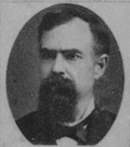18th Texas Infantry Regiment
The regiment was enrolled in Confederate service in May 1862 and always campaigned west of the Mississippi River in the region known as the Trans-Mississippi Department.
[3] Sometime in late 1862, part of the 18th Texas Infantry Regiment was mounted and ordered to ride south of the Rio Grande into Mexico to secure a large herd of cattle that was bought for the Confederate States.
The fatalities included Brigadier General Allison Nelson, commander of the Texas infantry, for whom the camp was named.
[4] At Camp Nelson, Brigadier General Henry E. McCulloch organized the Texas soldiers into an infantry division.
McCulloch assigned the dismounted 13th Texas Cavalry to the 1st Brigade under the command of Colonel Overton Young.
Subsequent commanders of the 1st Brigade were Brigadier Generals James Morrison Hawes, Thomas N. Waul, and Wilburn H. King.
After these captured troops were released by prisoner exchange, they served in Confederate armies east of the Mississippi River and never returned to the Trans-Mississippi Department.
The Texas division arrived at Richmond on the morning of 6 June where Walker received faulty intelligence which underestimated the Union strength at Milliken's Bend and Young's Point.
[10] On 7 June 1863, in the Battle of Milliken's Bend, McCulloch's 1,500 troops assaulted 1,061 Union soldiers led by Colonel Hermann Lieb.
The Union soldiers briefly held the levee in a brutal melee of bayonets and musket butts, before fleeing to the riverbank.
When the 1st Brigade arrived at Young's Point in an exhausted state, they were confronted by Union soldiers in formidable defenses, backed by gunboats.
The 18th Texas crossed the bayou in pursuit, and when the Union soldiers rallied in a nearby woods, Culbertson ordered his men to return to their original position.
Mower reported that his leading unit, the 5th Minnesota Infantry Regiment came into action and lost 1 man killed and 8 wounded.
[16] The division moved south to oppose a Union expedition led by Major General William B. Franklin.
The three Texas infantry regiments took part in a brilliant action at the Battle of Bayou Bourbeux on 3 November 1863.
After a three-hour fight, the Union force under Brigadier General Stephen G. Burbridge was driven from the field with losses of 200 killed and wounded, and 600 captured.
[21] In the Red River campaign, a Union force of 26,000 men led by Major General Nathaniel P. Banks and supported by 13 gunboats attempted to seize Shreveport.
In the rout, Banks' forces lost an estimated 200 killed, 900 wounded, 1,800 missing, 20 guns, and 250 wagons.
[24] On 9 April 1864, Taylor was reinforced to 14,300 troops and he attacked Banks' Union forces in the Battle of Pleasant Hill.



